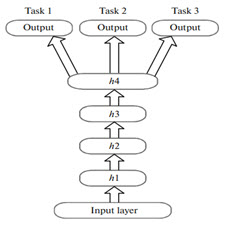توضیحات
ABSTRACT
The present work reports on a thermodynamic modeling of the Co–Pt system with ordered fcc phases of L10 and L12 structures by means of the CALPHAD method. The liquid, hcp and fcc phases have been modeled as substitutional solutions where the interaction parameters are composition dependent in the form of the Redlich–Kister polynomial. The disordered and ordered fcc phases have been modeled in terms of the compound energy formalism with a single Gibbs energy function. The obtained phase equilibria and activities of Co and Pt agree well with the available experimental data. First-principles calculations are performed to obtain the enthalpies of formation for the ordered fcc phases at 0 K. These calculated enthalpies of formations for the ordered phases are less negative than the enthalpies of the disordered state at low temperatures determined from the CALPHAD modeling. The Fe–Pt and Ni–Pt systems exhibit the same feature as that in the Co–Pt system, which is discussed in terms of the total magnetic moment of ordered fcc phases.
INTRODUCTION
Cobalt–platinum compounds have been used for their extraordinary catalysis properties in chemical reactions . The L10 CoPt alloy has been studied for the development of ultrahigh density magnetic storage media . The cobalt–platinum system is also an important component of the nickel based superalloy database such as in TTNI8 . The cobalt–platinum system exhibits an order/disorder transformation in the fcc solid solution, where the disordered (A1) phase at high temperatures orders into the L10 structure near 50 at.% Pt and the L12 structure near 25 and 75 at.% Pt. This phenomenon is found in many binary systems between platinum and transition metals such as Ni and Fe . A method for describing such fcc order/disorder transformations within the CALPHAD approach and the compound energy formalism has been developed using a four sublattice model . The four sublattice model, as the name implies, uses four sublattices to describe the four sites in the fcc tetrahedron, distinguishing the A1, L12, and L10 structures. With this method, experimental thermodynamic data for the disordered state such as the enthalpy of mixing and those for the ordered states such as enthalpies of formation and enthalpies for the disordered to ordered phase transformation can be used to evaluate the model parameters.
چکیده
در این مقاله، با استفاده از روش CALPHAD، یک مدلسازی ترمودینامیکی سیستم Co-Pt با مراحل فوکوس سفارش داده شده از ساختارهای L10 و L12 گزارش شده است. فازهای مایع، Hcp و FCC به عنوان راه حل های جایگزینی مدل سازی شده اند که در آن پارامترهای تعامل به صورت چند جملهای Redlich-Kister وابسته هستند. فازهای اختلال و دستورالعمل Fcc از لحاظ فرمولاسیون انرژی ترکیب شده با یک تابع انرژی گیبس تنها مدل سازی شده اند. تعادل فاز به دست آمده و فعالیت های Co و Pt به خوبی با داده های تجربی موجود توافق می شود. محاسبات اولی اصول برای به دست آوردن آنتالپی های شکل گیری برای فازهای دستورالعمل Fcc در 0 K انجام می شود. این آنتالپی محاسبه شده برای فازهای مرتب شده منفی کمتر از آنتالپی های حالت اختلال در دمای پایین تعیین شده از مدل سازی CALPHAD است. سیستم های Fe-Pt و Ni-Pt ویژگی مشابهی را در سیستم Co-Pt نشان می دهند که در مورد مجموع لحظات مغناطیسی مراحل Fcc مورد بحث قرار گرفته است.
مقدمه
ترکیبات کبالت-پلاتین برای خواص فوق العاده کاتالیزوری آنها در واکنش های شیمیایی استفاده شده است. آلیاژ L10 CoPt برای تولید رسانه های ذخیره سازی مغناطیسی با تکنولوژی فوق العاده مورد مطالعه قرار گرفته است. سیستم کبالت-پلاتین همچنین جزء مهمی از پایگاه داده فوق العاده آلومینیوم مبتنی بر نیکل مانند TTNI8 است. سیستم کبالت-پلاتین یک تغییرات نظم / اختلال در محلول جامد فسفات را نشان می دهد که در آن فاز اختلال (A1) در دمای بالا به ساختار L10 نزدیک به 50 درصد Pt و ساختار L12 نزدیک به 25 و 75 درصد در Pt . این پدیده در بسیاری از سیستم های باینری بین پلاتین و فلزات گذار مانند Ni و Fe دیده می شود. یک روش برای توصیف چنین تغییرات نظم / اختلال Fcc در روش CALPHAD و فرمالیته انرژی ترکیبی با استفاده از چهار مدل زیر القایی طراحی شده است. مدل چهار زیر مدل، همانطور که از نامش بر می آید، از چهار زیر لایه برای توصیف چهار سایت در تکته فركانسی Fcc استفاده می كند كه ساختارهای A1، L12 و L10 را تشخیص می دهند. با استفاده از این روش داده های آزمایشی ترمودینامیکی برای حالت اختلال مانند انتپالپی مخلوط و آنهایی که برای حالت های دستورالعمل مانند enthalpies شکل گیری و آنتالپی ها برای تبدیل فرآیند اختلال به مرتب شده می توانند برای ارزیابی پارامترهای مدل استفاده شوند.
Year: 2011
Publisher : ELSEVIER
By : DongEung Kim , James E. Saal , Liangcai Zhou , ShunLi Shang , Yong Du , Zi-Kui Liu
File Information: English Language/ 8 Page / size: 445 KB
Only site members can download free of charge after registering and adding to the cart
سال : 1390
ناشر : ELSEVIER
کاری از : دونگ یانگ کیم، جیمز ا. ساال، لیانگسی ژو، شون لی شانگ، یونگ دو، زی کیوی لیو
اطلاعات فایل : زبان انگلیسی / 8 صفحه / حجم : KB 445


![Thermodynamic modeling of fcc orderdisorder transformations in the[taliem.ir]](https://taliem.ir/wp-content/uploads/Thermodynamic-modeling-of-fcc-orderdisorder-transformations-in-thetaliem.ir_.jpg)

![rayanesh abri.[taliem.ir]](https://taliem.ir/wp-content/uploads/rayanesh-abri.taliem.ir_.jpg)
![Fabrication of Nanostructured Electroforming Copper Layer by Means[taliem.ir]](https://taliem.ir/wp-content/uploads/Fabrication-of-Nanostructured-Electroforming-Copper-Layer-by-Meanstaliem.ir_.jpg)


![Mechanical properties of foamed concrete exposed to high temperatures[taliem.ir]](https://taliem.ir/wp-content/uploads/Mechanical-properties-of-foamed-concrete-exposed-to-high-temperaturestaliem.ir_-150x150.jpg)

نقد و بررسیها
هنوز بررسیای ثبت نشده است.